10 Powerful Ways For Lead Generation Through Content Marketing

“What helps people, helps business,” said Leo Burnett. The whole point is about making content that genuinely helps people and eventually people will take care of your business. Just like the give-and-take approach.
This simple yet profound insight lies at the heart of successful lead generation through content marketing. Make sense?
So, in this comprehensive guide, we’re going to discuss how you can generate leads through content marketing the right way for your business.
Stay tuned and master lead generation.
What is content marketing lead generation
Here’s the concrete definition; content marketing lead generation is a strategic marketing approach focused on creating and distributing valuable, engaging, and relevant content to attract and convert potential customers into leads.
Marketers often utilize this method to address the needs of a specific target audience, establish the brand as an authority, and encourage individuals to share their contact information in exchange for valuable resources or information (lead magnets).
For instance, Let’s say you own a fitness apparel business. To attract customers, you create blog posts and videos about workouts, nutrition, and fitness trends. People interested in these topics provide their email for exclusive workout guides. Your content acts as a magnet, drawing in potential customers who, in return for valuable information, become leads. As you continue to share helpful content and nurture these leads, they will likely become your loyal customers.
Got that clear? Now let’s explore why content is an essential element of the lead generation strategy.
Why should you consider lead generation through content marketing
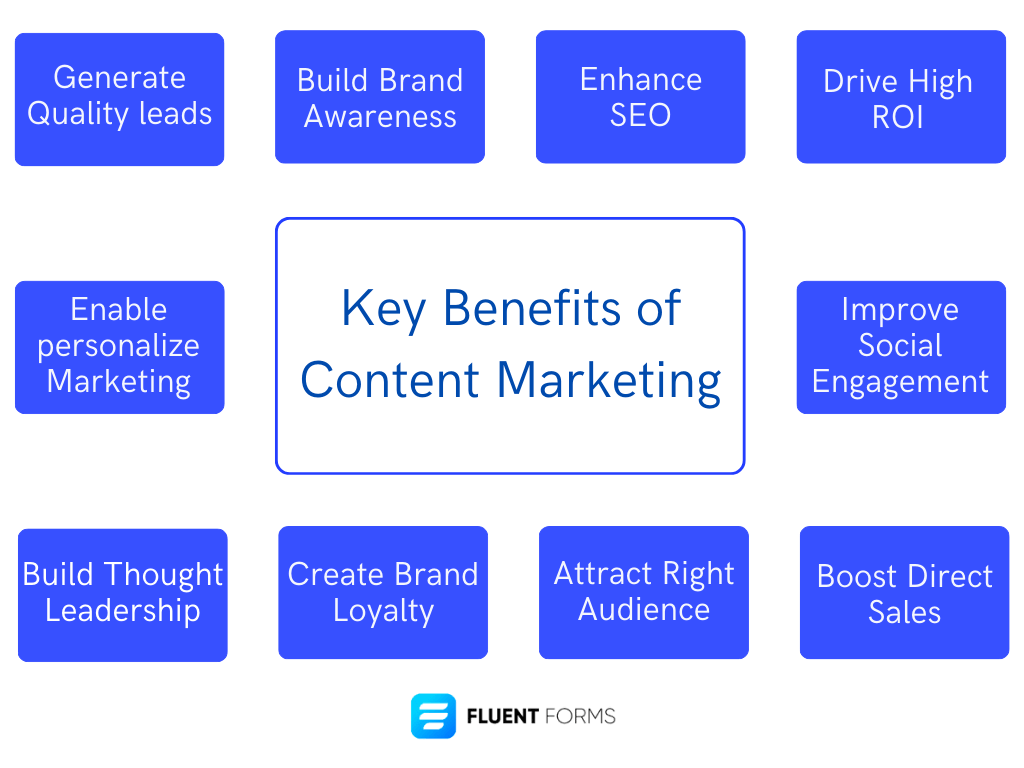
Because you want to capture quality leads for your business and that’s why content marketing is something irreplaceable. The benefits of content marketing for lead generation are so huge that you can’t overlook them.
Businesses that are thriving online must entice customers through content marketing. Here’s a list of some obvious benefits you can expect to gain from content marketing lead generation:
- It generates qualified leads: Relevant and valuable content acts as a magnet for potential leads. By addressing your target audience’s pain points and needs, you can attract prospects who are genuinely interested in your products or services, thereby increasing the likelihood of lead conversion.
- It increases brand awareness: Content acts as the voice of your brand. It allows you to showcase your values, mission, and unique selling propositions. Consistent and engaging content boosts brand recall and visibility, crucial for building lasting connections with your audience.
- It enhances SEO: Search engines prioritize high-quality, relevant content. Regularly updating your website with valuable content signals to search engines that your site is active and relevant. Eventually, it improves your chances of ranking higher in search results and attracting organic traffic.
- It improves social media engagement: Engaging content is shareable content. By creating content that resonates with your audience, you encourage social sharing, expanding your reach and boosting engagement, which can, in turn, contribute to lead generation.
- It builds thought leadership: Creating insightful and thought-provoking content establishes your brand as an authority in your industry. This thought leadership not only captures potential leads but also strengthens your overall brand image.
- It drives high ROI: Well-crafted content continues to provide value long after its creation. It can be repurposed across various channels, so it’s a cost-effective investment with the potential for long-term returns.
- It creates higher brand loyalty: Consistently delivering insightful content helps build a loyal audience. By providing ongoing value, you nurture a community around your business that ultimately results in higher customer retention and advocacy.
- It boosts direct sales: Strategic content can drive leads through the buyer’s journey by providing them with the information they need to make informed purchasing decisions. This, in turn, can lead to an increase in direct sales.
- It attracts the right audience: Crafting your content to address the specific needs and interests of your target audience ensures that you attract individuals who are more likely to convert into valuable leads.
- It enables personalized marketing: Analyzing the performance of your content allows you to understand your audience better. This data-driven approach lets you refine your targeting and deliver personalized content that enhances the effectiveness of your overall marketing efforts.
Certainly, content is not just a component but the lifeline of an effective lead generation strategy. Any business that wants to thrive online and generate quality inbound leads must try content marketing.
So, want to do lead generation through content marketing for your business? Let’s explore how to do it step-by-step.
How to generate leads through content marketing in 10 effective ways
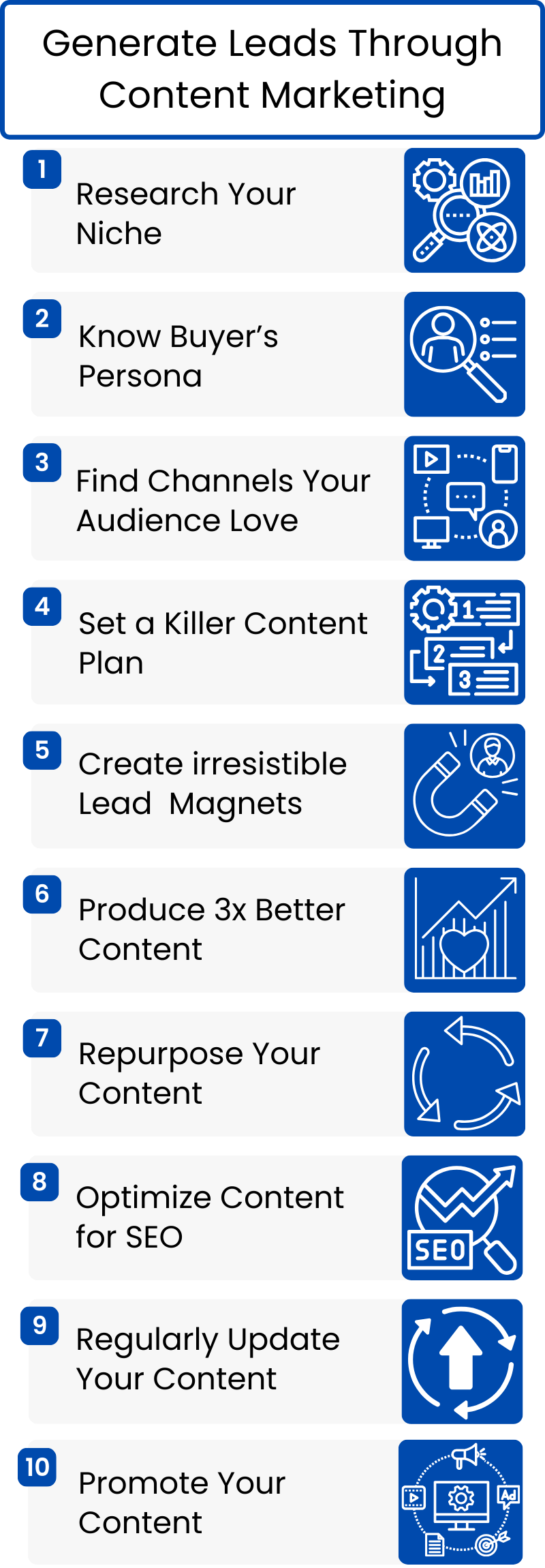
We are going to learn the process of lead generation through content marketing. We’ll discuss what it is, why it matters, and how you can properly conduct each step easily.
One more thing before we step in; you’ll find some steps are repetitive in the execution phase, this is because the process of doing things in digital marketing is somewhat similar. All you need is to believe in the process, and eventually, you’ll get the results.
So, let’s get in–
1. Research your niche on a deeper level
In order to create compelling content that resonates with your audience, it’s crucial to explore your niche to understand the industry trends, market dynamics, and challenges your audience faces.
Conduct thorough keyword research to identify the terms your potential customers are searching for. This approach is especially important for brands and creative performance agencies, as it helps tailor content for maximum visibility.
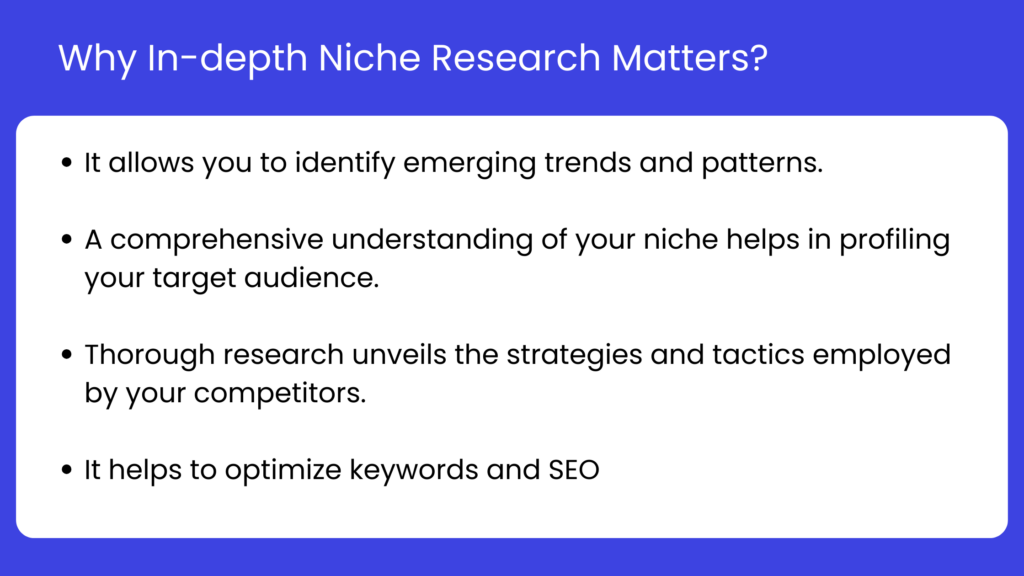
How to research your niche the right way
Here are the steps you should follow to research your niche:
Step 1- Define your niche: Clearly articulate the boundaries and focus of your niche. Understanding what sets your niche apart will guide your research in the right way.
Step 2- Explore Industry publications: Stay informed about the latest developments in your niche by regularly reading industry publications, journals, and authoritative blogs. This will keep you informed about trends, research findings, and expert opinions.
Step 3- Take assistance from online tools: Utilize online tools such as Google Trends, SEMrush, and Ahrefs to gather data on search trends, popular keywords, and competitor analysis. These marketing tools provide invaluable insights that can shape your content and marketing strategies.
Step 4- Engage in social listening: Monitor social media platforms and forums to understand the conversations around your niche. Social listening helps you identify pain points, concerns, and emerging topics within your community.
Step 5- Conduct surveys and interviews: Directly engage with your audience through surveys and interviews. This qualitative data provides a deeper understanding of their preferences, challenges, and expectations. You can use Fluent Forms’ quiz & survey feature for that.
Step 6- Analyze competitor strategies: Investigate your competitors’ websites, social media presence, and marketing strategies. Identify what works well for them and determine areas where you can offer something unique.
Step 7: Stay updated: Set up alerts and subscribe to newsletters to stay updated on the latest news and developments in your niche.
2. Get to know your buyers on a personal level
Crafting content that speaks directly to your audience begins with creating detailed buyer personas. Who are your customers? What motivates them? What challenges do they encounter?
By answering these questions, you can develop your content to address the specific needs and preferences of your ideal customers. This makes your messages more targeted and impactful.
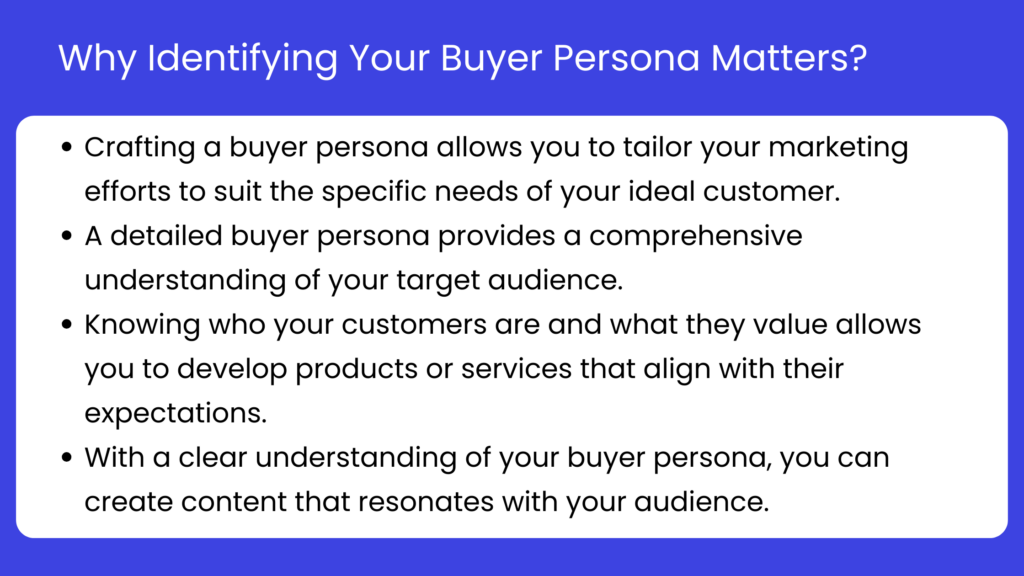
How to identify your buyer persona
Here are the 6 steps to conduct persona analysis.
Step 1- Gather demographic data: You should start with basic demographic information such as age, gender, location, and occupation. This builds the foundational layer of your buyer persona.
Step 2- Explore psychographic factors: Explore psychographic factors, including interests, hobbies, values, and lifestyle choices. You need to clearly understand what motivates and drives your audience beyond demographics.
Step 3- Conduct surveys and interviews: Engaging with your existing customer base through surveys and interviews is critical. Ask questions about their challenges, preferences, and purchasing behaviors. This direct feedback is crucial in shaping your buyer persona.
Step 4- Analyze customer interactions: Review your customer interactions on social media, customer support channels, and product reviews. This analysis provides insights into common concerns, feedback, and sentiments expressed by your audience.
Step 5- Collaborate across teams: Work closely with sales, customer care, and marketing teams to gather insights from different perspectives. Each department can contribute unique observations that enrich the overall understanding of your buyer persona.
Step 6- Utilize analytics tools: Use analytics tools to track website and social media interactions. Identify patterns in user behavior, popular content, and conversion points to refine your understanding of your audience.
3. Analyze channels your audience loves the most
Knowing where your audience spends their time online is key to effective content distribution. Whether it’s social media platforms, industry forums, or niche blogs; understanding these channels allows you to tailor your content strategy accordingly.
By meeting your audience where they are, you increase the likelihood of engaging with them on platforms they already frequent and that’s how you do effective lead generation through content marketing.
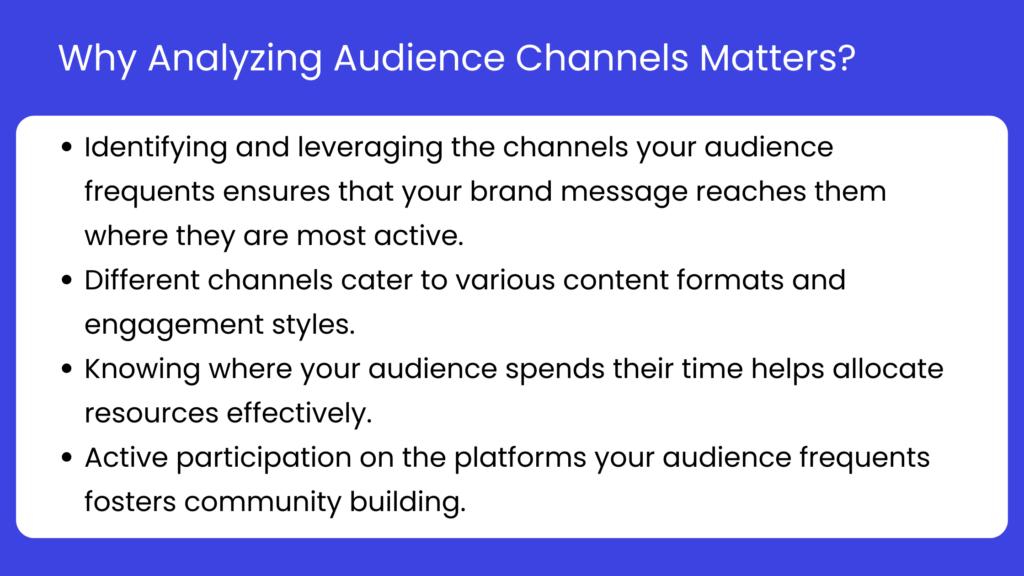
How to analyze audience channels
Here are the steps you should follow to analyze the channels that your audience loves the most:
Step 1- Understand your audience demographics: Define the demographic characteristics of your target audience. As we discussed earlier, this includes age, gender, location, interests, and occupation. This foundational information guides your exploration of relevant channels.
Step 2- Survey your audience: Directly inquire about your audience’s preferred channels through surveys or polls. Ask about their social media habits, content consumption patterns, and communication preferences to gain firsthand insights.
Step 3- Analyze website analytics: Utilize website analytics tools like Google Analytics to identify the sources of your traffic. Understand which channels drive the most visitors and conversions. This data provides a quantitative perspective on audience behavior.
Step 4- Monitor social media engagement: Track engagement metrics on various social media platforms. Identify which platforms and types of content generate the most interactions, shares, and comments.
Step 5- Explore industry-relevant Platforms: Research industry-specific forums, communities, and online spaces where your audience may be involved. Engaging with these niche platforms can drive highly targeted interactions.
Step 6- Competitor Analysis: Investigate the channels where your competitors are active. Analyzing their strategies can provide insights into the platforms that resonate with your shared audience and help you differentiate your approach.
Step 7- Stay Adaptable: Digital trends evolve, and audience preferences can also change. Stay adaptable by regularly revisiting your analysis and adjusting your channel strategy accordingly.
4. Set a killer content plan
A well-crafted content plan ensures consistency and relevance. Create a content calendar that aligns with your business goals and addresses the needs of your audience.
Include a mix of content types to match different preferences, and schedule releases strategically to keep a steady flow of information and engagement.

How to create a SMART content plan
You need an effective content plan so that you can efficiently conduct lead generation through content marketing. Here are the steps to follow:
Step 1- Define your objectives: Clearly defining your business objectives is crucial. Whether it’s increasing website traffic, boosting engagement on social media, or generating leads, your content plan should align with these goals.
Step 2- Understand your audience: Know your target audience profoundly. You need to understand their preferences, pain points, and behaviors. This audience-centric approach ensures that your content resonates with the people you want to reach.
Step 3- Content calendar creation: Create a content calendar outlining the types of content you’ll create, publication schedules, and the channels in which it will be distributed. This calendar serves as a roadmap for your content strategy.
Step 4- Diversify content formats: Explore a variety of content formats such as blog posts, videos, infographics, podcasts, and more. Diversifying your content keeps your audience engaged and satisfies different learning and consumption preferences.
Step 5- Keyword and SEO integration: Conduct keyword research and integrate SEO best practices into your content. This optimization enhances your content’s discoverability and ranking on search engines and helps you drive organic traffic to your platforms.
Step 6- Monitor and analyze performance: Regularly track and analyze the performance of your content. Utilize analytics tools to measure key metrics such as engagement, conversion rates, and audience demographics. Use these insights to refine and enhance your content plan.
5. Create irresistible lead magnets
Offer your audience valuable resources they can’t resist. Whether it’s an in-depth ebook, an exclusive webinar, or a downloadable template, these lead magnets serve as incentives for visitors to share their contact information.
Also, an effective lead magnet is a powerful tool for capturing email addresses from potential customers and growing your email list.
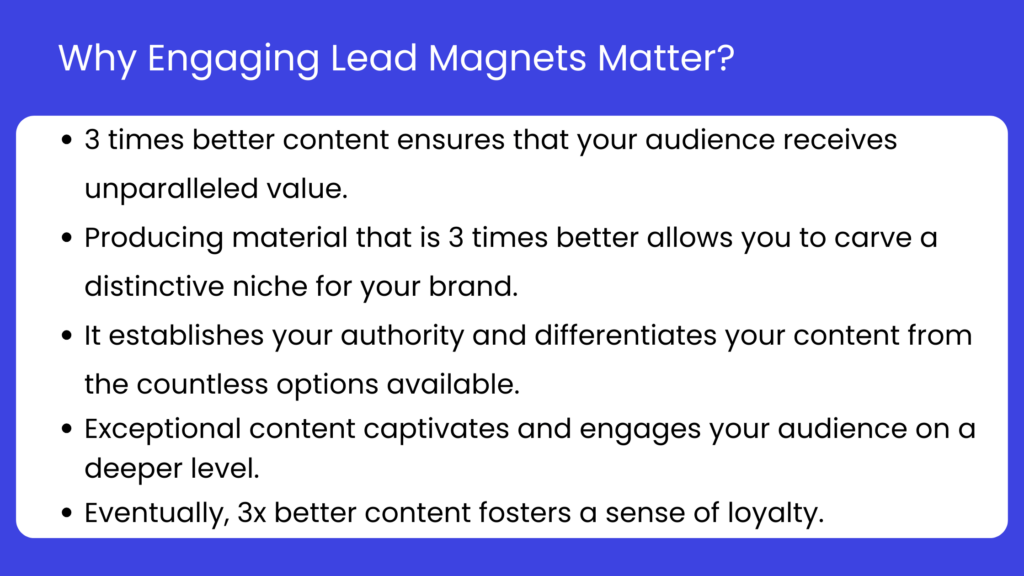
How to create engaging lead magnets
Here are the steps you should follow to create killer lead magnets:
To execute lead generation through content marketing, you need to create captivating lead magnates. Here’s how you can do it:
Step 1- Know your audience: Conduct thorough audience research to understand their preferences, challenges, and aspirations. Craft your lead magnets to address specific pain points and provide solutions.
Step 2- Offer real value: The key to an engaging lead magnet is offering something of real value. This could be in the form of exclusive content, resources, tools, or discounts. Ensure that your audience sees the immediate benefit.
Step 3- Address specific pain points: Identify the pain points your audience is experiencing and tailor your lead magnet to address those specific challenges. Set your incentive as the solution they’ve been searching for.
Step 4- Create visually appealing designs: Presentation matters. Ensure that your lead magnet is visually appealing and easy to consume. Use high-quality graphics, clear formatting, and an enticing design to enhance engagement.
Step 5- Optimize landing pages: The landing page for your lead magnet should be optimized for conversions. Craft compelling copy, use persuasive headlines, and include a clear call-to-action that guides visitors to take the desired next step.
Step 6- Utilize multiple formats: Offer lead magnets in various formats that resonate with different preferences. This could include ebooks, checklists, webinars, templates, or free trials. Diversifying your offerings broadens your appeal.
Step 7- Implement A/B testing: Experiment with different lead magnets and analyze their performance through A/B testing. This process helps you refine your approach and identify the most effective incentives for your audience.
6. Outperform competitors; produce 3x better Content
Strive for content that surpasses expectations. Your content should not only answer questions but also provide unparalleled value.
Whether it’s through in-depth research, unique insights, or innovative presentation, aim to create content that overruns what’s already available in your niche.

How to create better content
Here are the steps to create 3 times better content:
Step 1- Audience-centric approach: Start by deeply understanding your audience – their needs, preferences, challenges, and aspirations. Tailor your content to address their specific pain points and desires, making it relatable and valuable.
Step 2- Compelling storytelling: Weave narratives that resonate emotionally. Storytelling creates a connection with your audience, making your content memorable. Whether it’s a brand story, customer testimonial, or case study, evokes emotions that leave a lasting impact.
Step 3- Visual appeal: Incorporate visually appealing elements into your content. Use high-quality images, infographics, and videos to enhance comprehension and engagement. A visually stimulating presentation makes your content more shareable and memorable.
Step 4- Interactive elements: Implement interactive elements such as quizzes, polls, and surveys. Interactive content not only engages your audience but also provides valuable insights into their preferences and behaviors.
Step 5- Utilize Data: Use data analytics to understand what works and what doesn’t. Analyze metrics like engagement, bounce rates, and conversion rates. This data-driven approach helps you refine your content strategy for optimal results.
Step 6- Diversify content formats: Experiment with various content formats to cater to different learning styles. Incorporate blog posts, videos, podcasts, infographics, and more. Diversifying your content portfolio enhances audience engagement and reach.
Step 7- Clear and actionable CTAs: Every piece of content should guide your audience towards a specific action. Craft clear and compelling calls-to-action (CTAs) that prompt users to subscribe, download, share, or make a purchase.
Step 8- Consistent brand voice: Maintain a consistent brand voice across all content. Whether it’s a blog post, social media update, or email newsletter, your audience should recognize and resonate with your brand’s personality.
Step 9- Search engine optimization: Incorporate SEO best practices into your content strategy. Conduct keyword research, optimize meta tags, and create content that aligns with search intent. This ensures that your content is discoverable by a wider audience.
Step 10- Continuous learning and improvement: Stay informed about industry trends, content marketing best practices, and emerging technologies. Continuous learning allows you to adapt and incorporate fresh ideas into your content strategy.
7. Strategically repurpose your content
Extend the lifespan of your content by repurposing it into different formats. Turn a popular blog post into a video, transform statistics into engaging infographics, or create a podcast discussing key insights.
Repurposing allows you to reach new audiences and reinforces your message through varied mediums.
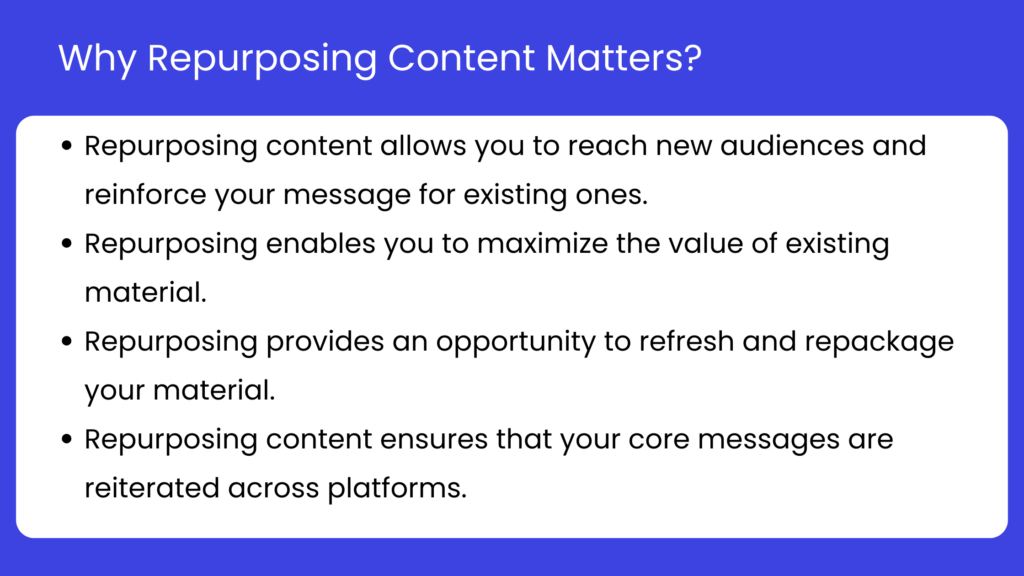
How to do content repurposing
Here are the steps you should follow to repurpose existing content:
Step 1- Audit your existing content: First of all, conduct a thorough audit of your existing content. Identify high-performing pieces that can be repurposed and have the potential to resonate across different channels.
Step 2- Identify repurposing opportunities: Pinpoint the formats that suit your content best for repurposing. For example, a blog post could be transformed into an infographic, podcast episode, or a series of social media posts.
Step 3- Create content for different platforms: Adapt your content to fit the nuances of various platforms. What works on Instagram might need adjustments for LinkedIn. Craft your messaging, format, and visuals to align with each platform’s unique characteristics.
Step 4- Create bite-sized snippets: Break down longer content into bite-sized snippets. This could include pulling out key quotes, statistics, or insights for social media posts.
Step 5- Produce visual content: Visuals are powerful tools for engagement. Transform written content into visually appealing infographics, images with quotes, or videos. Visual content tends to capture attention and is highly shareable.
Step 6- Republish and update: Republish evergreen content with updates to keep it relevant. This is particularly effective for blog posts or articles that continue to provide value over time. Update statistics, case studies, or examples to maintain accuracy.
Step 7- Utilize user-generated content: Encourage your audience to create content around your existing material. This could include reviews, testimonials, or social media posts. User-generated content adds authenticity and expands your content reach.
Step 8- Experiment with new formats: Explore new content formats that align with emerging trends. For instance, consider turning written content into interactive quizzes, polls, or immersive experiences to keep your audience engaged.
8. Master SEO for your content
Make your content easily discoverable by optimizing it for search engines. Identify and incorporate relevant keywords naturally into your content. Ensure meta tags, headers, and images are all optimized.
It enhances your chances of ranking higher in search engine results pages (SERPs) and driving organic traffic.
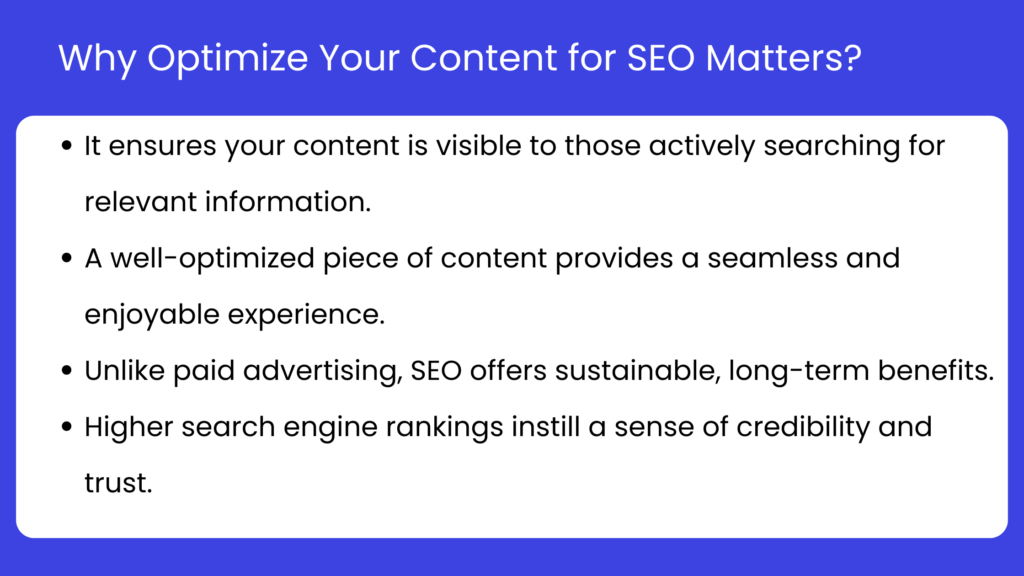
How to optimize content for SEO
When it’s about lead generation through content marketing, there’s no better way than optimizing content for SEO to generate organic leads. Here’s how you can do it.
Step 1- Keyword research: The first thing you need to do is conduct thorough keyword research. Identify relevant keywords and phrases that align with your content and are frequently searched by your target audience.
Step 2- Strategic keyword placement: Incorporate your selected keywords strategically. Place them in the title, headings, meta descriptions, and naturally throughout the content. However, ensure that the text flows naturally and doesn’t feel forced.
Step 3- Titles and meta descriptions: Craft compelling titles and meta descriptions that not only contain keywords but also entice users to click. A well-crafted meta description is like a mini-advertisement for your content.
Step 4- Optimize images: Don’t overlook the power of image optimization. Use descriptive file names, add alt text, and compress images to ensure they don’t slow down your page loading speed.
Step 5- Mobile-friendly design: Google prioritizes mobile-friendly content. Ensure that your website is responsive and provides an excellent user experience on various devices.
Step 6- Improve page loading speed: Users and search engines love fast-loading pages. Optimize images, utilize browser caching, and minimize unnecessary scripts to improve your page loading speed.
Step 7- Quality content: Content quality matters, it matters the most. Create informative, valuable, and engaging content that addresses user queries. Google’s algorithms are designed to prioritize comprehensive content that provides genuine value.
Also, be cautious with AI-generated text, as it often follows predictable structures, phrasing and logic patterns that both search algorithms and any advanced AI detector can identify.
Step 8- Build quality backlinks: Earn quality backlinks from reputable sources. These serve as endorsements for your content that indicate to search engines that your content is authoritative and valuable.
Step 9- Utilize internal linking: Incorporate internal links to connect related content within your website. This not only improves navigation but also helps search engines understand the structure and hierarchy of your content.
Step 10- Regularly update content: Google favors fresh content. Regularly update or paraphrase the existing content to reflect any changes or new information. This signals to search engines that your content is current and relevant. We have a dedicated discussion for this, so let’s explore point number 9.
9. Keep your content up-to-date
To maintain relevance, regularly revisit and update your existing content. Update statistics, refresh information, and add new insights.
This not only keeps your content accurate but also signals to search engines that your content is current and deserves attention.
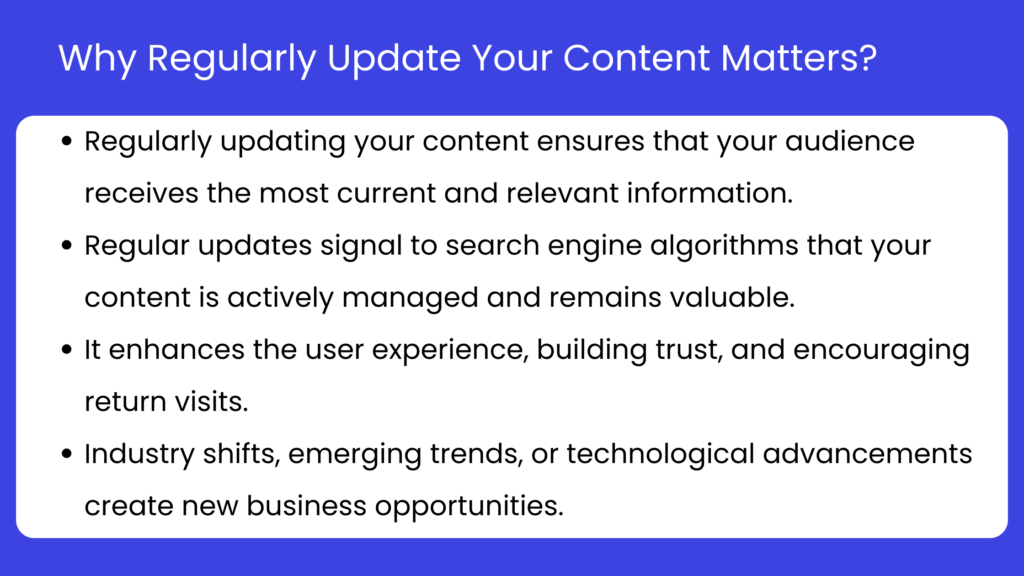
How to update your content
Here are the steps you should follow to regularly update your content:
Step 1- Create an update schedule: Establish a content update schedule to systematically review and refresh existing content. This could be monthly, quarterly, or as needed based on industry changes.
Step 2- Monitor industry trends: Be aware of industry trends, technological advancements, and changes in consumer behavior. Regularly update your content to align with these shifts and provide valuable insights to your audience.
Step 3- Update statistics and data: If your content relies on statistics or data, ensure that these figures are up to date. Outdated information can undermine the credibility of your content.
Step 4- Revise and expand: Periodically revisit your evergreen content and consider ways to revise and expand it. Add new sections, include additional insights, or refresh the write-up using a paraphraser to keep it engaging.
Step 5- Refresh visuals: Visual elements play a crucial role in content engagement. Update images, infographics, and other visuals to maintain a modern and appealing look.
Step 6- Address user feedback: Pay attention to user feedback and comments. If your audience points out areas for improvement or requests more information, use this feedback to guide your content updates.
Step 8- Add internal and external links: Incorporate internal links to newer content on your site. This not only improves your site’s overall structure but also helps distribute traffic to more recent posts. Additionally, update external links to reputable sources.
Step 9- Utilize social media: Share your updated content on social media platforms, notifying your audience of fresh insights or information. This can drive additional traffic and engagement.
10. Promote Your Content to the fullest
When it’s about lead generation through content marketing, there’s a popular saying that goes “Even the most valuable content won’t generate leads if it’s not seen”. So, it’s crucial to actively promote your content across all relevant channels. Utilize social media, email marketing, and partnerships to amplify your reach.
Encourage sharing and engagement to increase your content’s visibility and impact.
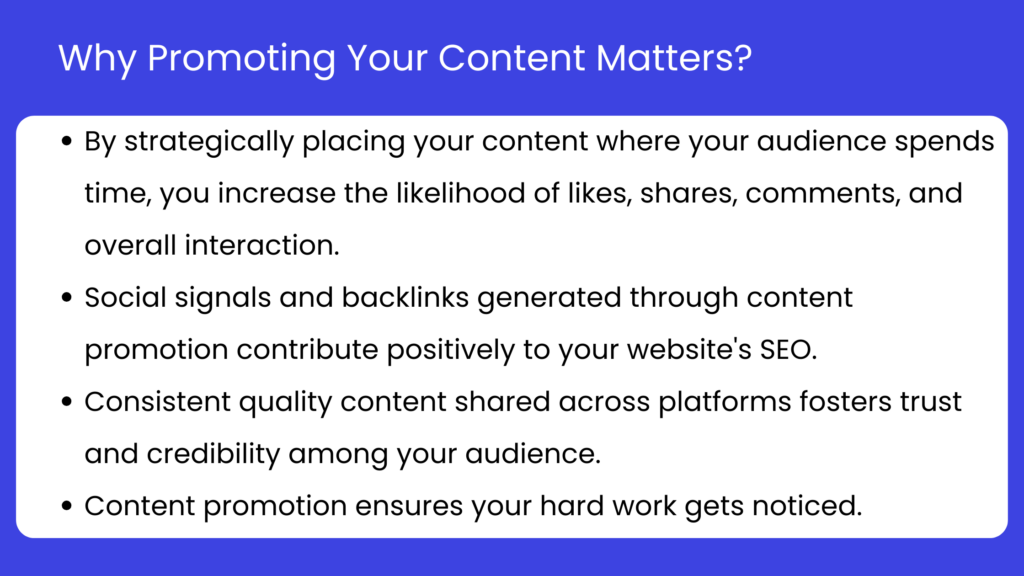
How to promote content effectively
Here are the steps you should follow to promote content effectively:
Strategy 1- Utilize social media: Share your content across various social media platforms. Craft engaging captions, use relevant hashtags, and encourage your audience to share. Utilize different formats, including images, videos, and infographics.
Strategy 2- Email marketing: Utilize your email list to promote new content. Craft compelling email newsletters with a teaser or snippet of your content, prompting subscribers to click and read more.
Strategy 3- Collaborate with influencers: Partner with influencers or thought leaders in your industry. Their endorsement can significantly amplify the reach of your content to their established audience.
Strategy 4- Optimize for search engines: Ensure your content is optimized for search engines. Use relevant keywords, meta descriptions, and alt tags. High-ranking content naturally attracts more visibility.
Strategy 5- Engage in online communities: Participate in relevant online communities and forums. Share your content where it adds value to the conversation. Avoid overly promotional tactics; focus on providing solutions.
Strategy 6- Paid advertising: Invest in paid advertising on platforms like Google Ads or social media. Target specific demographics to ensure your content reaches the most relevant audience.
Strategy 7- Repurpose and share: Repurpose your content into different formats (videos, podcasts, infographics) and share across diverse channels. This maximizes the potential audience reach.
Strategy 8- Collaborate with other brands: Make partnerships with complementary brands. Co-create content or cross-promote each other’s material to tap into each other’s audience.
Strategy 9- Run contests and giveaways: Encourage engagement through contests or giveaways related to your content. This not only boosts visibility but also incentivizes your audience to share.
One more thing to remember is that successful lead generation through content marketing strategy is an ongoing process that requires adaptation and refinement based on audience feedback and changing market dynamics.
So, hope you are all clear about how to generate leads through content marketing. Here’s one more essential thing to discuss.
What are the best types of content to generate leads
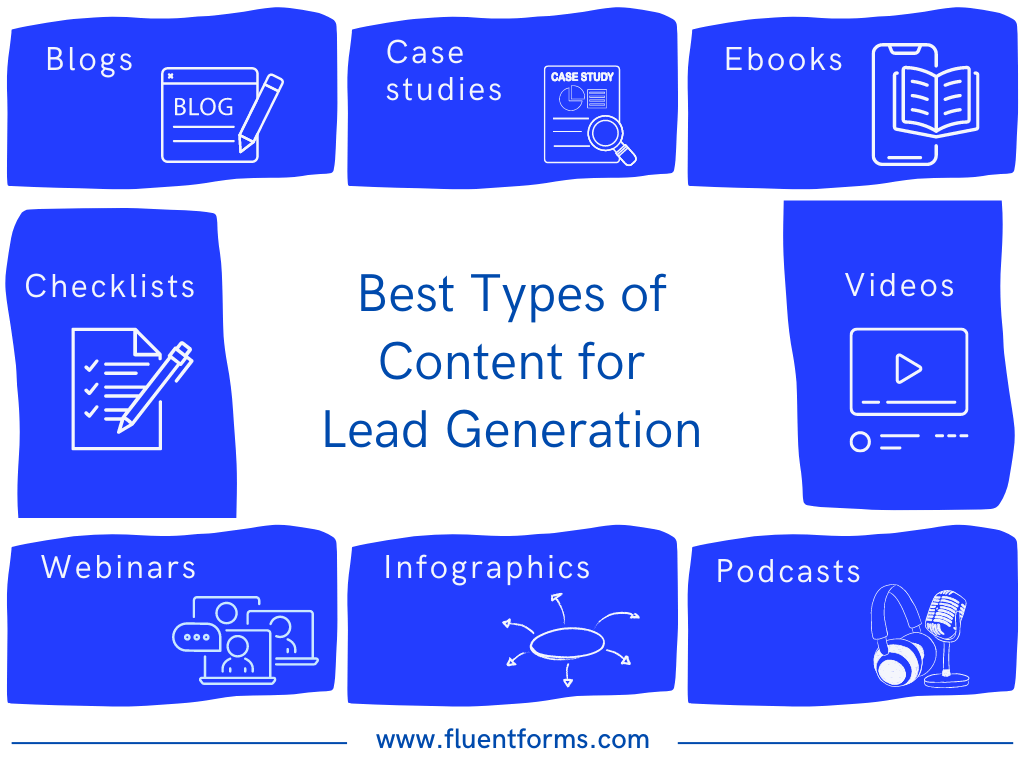
Knowing what kind of content is the best for lead generation in your industry is crucial. Here are a few types of content that work best for lead generation:
1. Blogs

Blogs are written articles published on a website. It offers valuable and relevant information to the target audience. Blogs help build brand authority, improve SEO, and engage potential leads through informative and shareable content.
2. Case Studies

Case studies are in-depth analyses of specific projects, showcasing how a product or service solved a real problem for a customer. They provide social proof and demonstrate the practical application of your offerings.
3. Ebooks

Ebooks are comprehensive, downloadable documents that deeply analyze a particular topic or issue. They are often more extensive than blog posts, offering in-depth insights, research, and actionable advice to position your brand as an industry authority.
4. Checklists
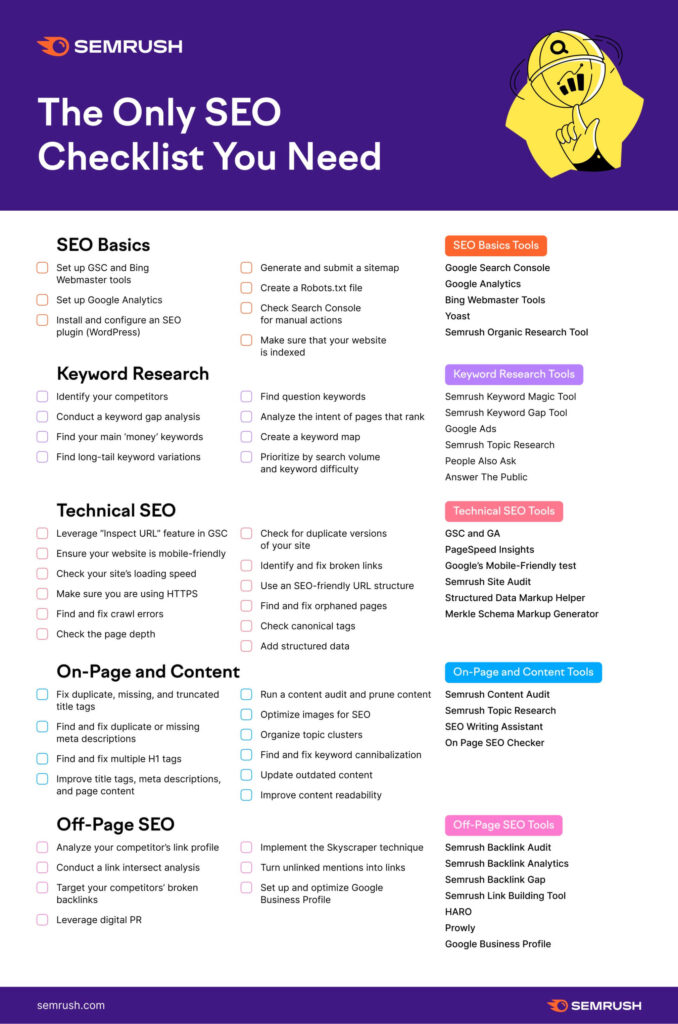
Checklists are concise lists of tasks or items that help users organize and simplify complex processes. They are easy to consume and offer practical value, making them an effective tool for capturing leads looking for actionable guidance.
5. Videos
Videos use visual and auditory elements to convey information. They can include product demonstrations, tutorials, testimonials, or storytelling to engage the audience. Videos are highly shareable and can increase brand visibility.
6. Webinars

Webinars are live or pre-recorded online events that allow presenters to share information, insights, and interact with the audience in real-time. They are valuable for educating leads on complex topics, addressing questions, and establishing a direct connection.
7. Infographics

Infographics are visual representations of data, information, or knowledge. They present complex information in a visually appealing and easy-to-understand format. Infographics can quickly grab attention and are often shared across social media platforms.
8. Podcasts

Podcasts are audio content distributed as a series of episodes. They provide a convenient way for users to consume information on the go. Podcasts can feature interviews, discussions, or storytelling that offer a personal connection with the audience.
Certainly, each type of content serves a specific purpose in the lead generation process, and incorporating a mix of these formats into your strategy can effectively reach a diverse audience with diverse preferences and interests.
Let’s wrap up
Experts often say that every successful lead-generation effort begins with valuable content. Any thriving business understands that lead generation through content marketing is the real game-changer when it comes to attracting potential customers.
So, as we’ve discussed, it’s crucial to understand that consistently creating awesome and compelling content is the key to skyrocketing your business growth. As mentioned earlier, simply believe in the process, keep doing it right, and drive mindful results for your business.

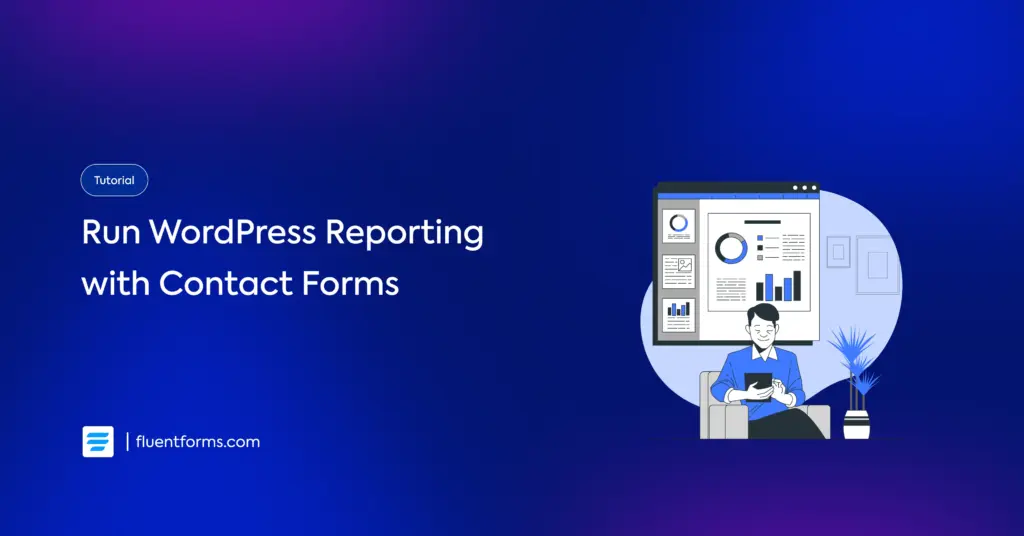
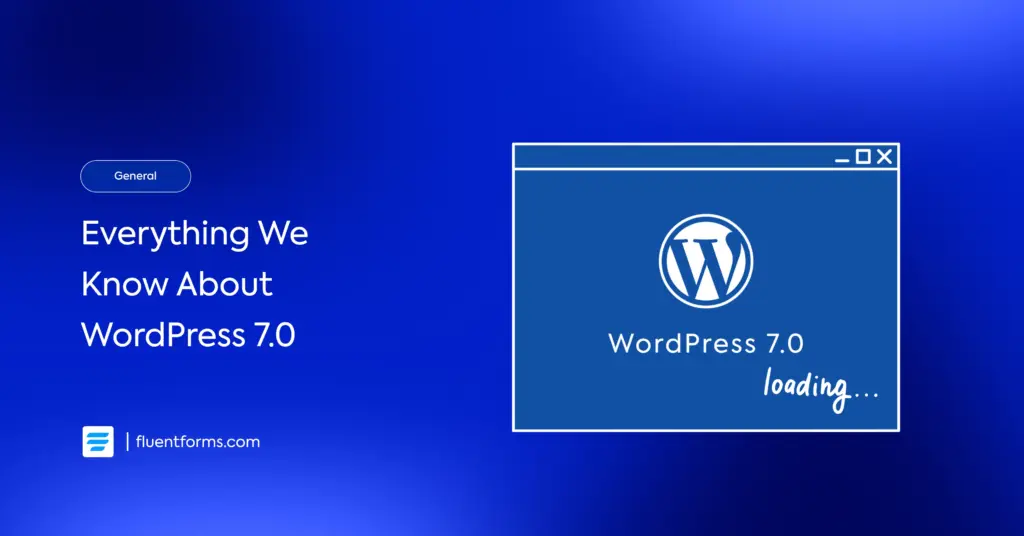




Leave a Reply